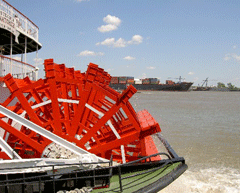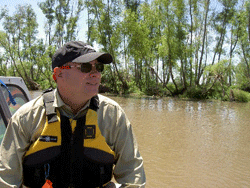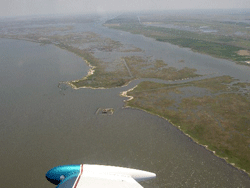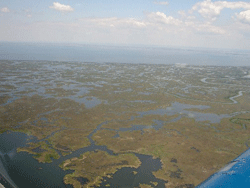A Checkered Past
Air Date: Week of June 2, 2006

Rolling on the River: From sternwheelers to cargo ships, commerce on the Mississippi built New Orleans. The river also built all of southeast Louisiana's land. (Photo: Jeff Young)
How did New Orleans end up with such a flawed storm protection system? Living on Earth's Jeff Young traces the history of the region's levees and finds misplaced priorities, political squabbles and a coastline sinking around the rising floodwalls.
Transcript
CURWOOD: It’s Living on Earth, I’m Steve Curwood. By now it’s clear that Hurricane Katrina did not drown New Orleans by herself. The city flooded because its levees and floodwalls failed in the face of a challenge they should have contained.
Those walls against the water were tangible expressions of a community’s trust. People trusted their homes, belongings – their very lives – to a hurricane protection system that was 40 years in the making and then undone in a day.
Living on Earth’s Jeff Young reports on how that flawed levee system came about. It’s a history full of skewed priorities, political squabbles and unintended consequences for a river, the land it built, and the people who live on it.

Rolling on the River: From sternwheelers to cargo ships, commerce on the Mississippi built New Orleans. The river also built all of southeast Louisiana's land. (Photo: Jeff Young)
YOUNG: The Mississippi River built New Orleans.
[STERNWHEELER WHISTLE BLOWS, MORE CHURNING WATER]
YOUNG: From sternwheelers like this one to today’s ocean going vessels, commerce on the river made New Orleans one of the country’s busiest ports. But the river built this city in a more literal sense: it actually made all this land.
REED: Oh yeah, the whole of southeast Louisiana was built by the river.
YOUNG: Wetlands ecologist Denise Reed sits by the river across town from where she teaches at the University of New Orleans. Reed explains how for millennia the Mississippi picked up sediment from its enormous drainage and left it here.
REED: About every one thousand years or so, we think, the river built land in one area, then another, then another. And by the time we stopped it doing that it was going down the location that it presently does through the city of New Orleans. And so we’ve locked it into position now. It doesn’t swing around the coast like a hose pipe building land. When we did that, when we contained the river and tamed it within the levees, there were some unintended consequences.
YOUNG: River delta land is soft and loose and compacts over time. Without more sediment from river floods, the land sinks. And in the past 60 years or so, the marshes have been carved up with canals – thousands of them – for navigation and for the many oil and gas wells and pipelines. That let salt water from the Gulf of Mexico rush in, killing fresh water marsh.
REED: What it means is that we’re sitting on the delta of the sixth largest river in the world and it’s in fundamental decline. Much of the marsh and wetland that we have lost during the 20th century…it’s difficult to envisage how we could get that back. The system is so seriously deteriorated. Some parts of the coast are just not there anymore.
YOUNG: The city sank, and the coast shrank. In an average year Louisiana loses 24 square miles to open water. By 2050 it could lose another 500. That land sheltered migrating birds and one of the country’s richest fisheries. It was also south Louisiana’s buffer against storms raging in from the Gulf of Mexico. But then, people had a pretty good reason to build levees along the river.
[ARCHIVE SOUND NEWSREEL]
NARRATOR: …1927 brought havoc to Mississippi as torrents of water poured through the lowland states from Illinois to the Gulf…
[NEWSREEL DRAMATIC MUSIC UNDER]
BARRY: The river was this enormous force. That flood hit the homes of nearly 1 percent of entire population of the country.
YOUNG: Historian and New Orleanian John Barry. His book, Rising Tide, tells how the great flood of 1927 changed the region and its relationship with the river.
BARRY: They strengthened the levees significantly after the ’27 flood. They have not had a major flood break those levees since 1927.
YOUNG: Controlling the Mississippi became the top job for the Army Corps of Engineers. University of Maryland engineering professor and retired General Gerald Galloway knows how big a job that was. He served 38 years in the Corp.
GALLOWAY: The Mississippi was the big tiger that they were wrestling with. That’s the front door to New Orleans. The back door was the coastal protection from hurricanes. In 1965 Hurricane Betsy alerted everybody to the fact that you could put New Orleans under water from the back door.
[JOHNSON LIBRARY ARCHIVE TAPE]
LBJ: Is your home under water?
WM: Oh yes, water. About three feet to the house.
LBJ: What's happened to your neighbors?
WM: Well they the same way. They're the same way, sir.
YOUNG: President Lyndon Johnson comforted storm survivors just after Hurricane Betsy took that “back door” into the city. Water roared up an inland bay called Lake Borgne. From there it spilled into the city’s east via a canal just completed that year, called the Mississippi River Gulf Outlet. Water also swamped the city’s north from Lake Pontchartrain. Johnson pledged federal help.
[LBJ ARCHIVE TAPE]
LBJ: This state will build its way out of its sorrow. And the national government will be at Louisiana's side to help it every step of the way in every way that we can.
[APPLAUSE]
YOUNG: Hurricane Betsy spurred Congress to fund the first Army Corps plan to protect New Orleans from storms. That started 40 years of work on the 125-mile levee system – a system still not finished today. The original plan also called for more: a large storm surge barrier. When open, it would allow boats and normal tidal flow between Lakes Borgne and Pontchartrain. When closed, it would keep storm waters from surging into Pontchartrain and the city’s north. But that plan ran into a different kind of storm. Again, Gerald Galloway:
GALLOWAY: From the very beginning the construction of the hurricane protection system around New Orleans was fraught with lots of challenges.
YOUNG: The first was a lawsuit challenging the surge barrier. Communities on the lake’s north shore worried it put them in greater danger. And environmentalists argued it would damage the lake ecosystem. A federal judge agreed and sent the surge barrier back to the drawing board in the 70s. Vald Heiberg was district chief of the Corps at the time.
HEIBERG: We, the Corps of Engineers, never got beyond that point. I ended up being the head of the Corps and was the guy a decade later who said, ‘okay, we’re just gonna quit trying. We’ll just try to build those levees in New Orleans higher.’ I don’t know if that was the right idea. As I’ve told some people, that might have been the worst thing I ever did as chief of engineers.
YOUNG: After Katrina, the idea of surge barriers is back and still controversial. A recent report from the Government Accountability Office says it’s likely Katrina’s surge would have overtopped the barrier as it was originally designed. That could have made flooding even worse, because the original plan called for lower levees around the city.
But Heiberg and other former high-ranking Corps members insist New Orleans needs a surge barrier. They say a new design coupled with higher levees could protect against storms without harming the environment.
In any event, when the surge barrier plan died in the 70s, the Corps had to rethink its protection for New Orleans. They shifted focus to the city itself and three major weak points: the canals that carry rain water out to the lake could also let storm surge into the very heart of the city.
BARRY: You know, when you take on your enemy you generally don’t want to invite the enemy into your living room for the battle. And that’s essentially what happened.
YOUNG: Historian John Barry says the Corps proposed decades ago to put gates where each canal meets the lake – so canals made to drain out didn’t instead allow lake water in - very much like the ones they’re racing to build today. But politics intervened.
BARRY: The local politicians ordered the Corps, through legislation, not to do that because they felt it was too expensive. They didn’t want to pay their share.
YOUNG: With no surge barrier on the lake and no gates on the canals, the only plan left was to simply line the canals with higher levees and walls – levees and walls that fell when Katrina took the same back door to New Orleans that Betsy found open 40 years before. Barry says there’s plenty of blame to go around. But he places most of it squarely on the Army Corps.
BARRY: When the Corps looks at itself in the mirror I think there are some real problems here. There were many compromises that the Corp made. A lot of those compromises were forced upon it, but not all of them. Yeah, I’m pretty disappointed in the work they did.
YOUNG: Of course that levee work is now the focus of intense scrutiny. But Retired Corps General Gerald Galloway says the problems really started before the work began.
GALLOWAY: I would argue that the problem began when we failed to specify the level of protection to be provided.
YOUNG: All along, the Corps’ plan to protect New Orleans was based on a late ‘50s study by the weather service guessing the strength of storms most likely to hit. It was called the standard project hurricane.
GALLOWAY: When we picked the standard project hurricane for New Orleans we were picking low, not high. We went in the wrong direction. Instead of taking the biggest storm that we could conjure we took a sort of moderate storm. And as we’ve seen the results were disastrous.
YOUNG: The Corps upgraded its storm calculations with a study in the late ‘70s. Louisiana State University Hurricane Center Director Ivor Van Heerden says the Army even issued a directive in 1981 to use those new findings and design protection for a stronger storm.
VAN HEERDEN: Unfortunately the Corps seems to have stayed with the 1959 definition of a standard project hurricane, which was a much, much weaker storm.
YOUNG: They paid for this study. Why didn’t they use it?
VAN HEERDEN: We see cost cutting efforts one after the other. And we see this term in the internal correspondence – about this will cut costs, this will cut costs. So it looks like, perhaps, that the use of a weaker hurricane meant you didn’t have to build levees as robust or as high and as a result you cut your costs.
YOUNG: So was the problem a shortage of money? The storm protection system was still not complete when Katrina hit. And the Bush administration had cut maintenance budgets for levees. But still, Louisiana got more money for Corps projects over the past five years than any other state – nearly two billion dollars.
Steve Ellis is with the budget watchdog group Taxpayers for Common Sense.
ELLIS: So it wasn’t that we didn’t spend enough money; it was going to the wrong things. Rather than concentrating our resources and maintaining what we had, and trying to actually provide adequate or better flood protection, we were building other things across the state.
YOUNG: Ellis says Corps projects too often waste money and hurt the environment. The Corps says it’s changed to make restoration a major part of its mission. Two Corps projects just a few miles apart provide evidence for both arguments: the Mississippi River Gulf Outlet and the Caernarvan diversion.
[OUTDOORS ON CAERNARVAN LEVEE]
YOUNG: So, I’m walking along the Mississippi River levee downstream of New Orleans at a big bend in the river called English Turn in Saint Bernard’s Parish. There’s a little community called Caernarvan. Now Caernarvan is locally infamous in history, because in 1927, during the Great Flood, the powers that be that ran New Orleans dynamited the levee, right here.
Well it’s one of those funny coincidences of history that if you visit Caernarvan these days you’ll find there’s another intentional hole in the levee. Listen, you can hear some of the Mississippi River rushing through the levee. This time the goal is to use that water to save some of the disappearing wetlands.
VILLARUBIA: This is right near the spot where the levee was blown up. And so we’re trying to replicate that, albeit in a much in a smaller way.

A River Runs Through It: Biologist Chuck Villarubia checks the flow at the Caernarvan freshwater diversion. The willows behind him have grown where there was once open saltwater. (Photo: Jeff Young)
VILLARUBIA: What we have is a series of five tubes that are 15 by 15 feet. That then distributes water from the river into the marsh. What this does is help simulate the over-bank flooding that happened before the levees were here.
YOUNG: And are we gonna open the gates here?
VILLARUBIA: Yeah, we can open the gates and show ya how it works.
[SOUND OF RUSHING WATER]
YOUNG: With the gates fully open, 8,000 cubic feet per second of muddy Mississippi rush through. In some parts of the country that would be a river itself. But it’s spare change here.
[WATER SOUND, THEN SOUND OF BIRDS, A LITTLE WIND]
YOUNG: The river water pushes back saltwater from some abandoned fields. Now the marsh is starting to come back, as is wildlife.
VILLARUBIA: Yeah, that’s him right now. There’s an alligator – that’s a half way decent sized one – kind of checking us out a little bit.
YOUNG: The concern about losing wetlands and the land its self is so great, it must be really satisfying to come here and say, ‘We’re starting to turn the tide,’ at least a little.
VILLARUBIA: Caernarvan has been successful. It’s been nice to see it work. And particularly now, after the hurricane, we’ve seen that, and we know that we need to have this marsh in front of the levees to make them more effective. Most of the levees look fine here, at least in this area. So we need to make this wetland restoration work along with levees for the protection of the whole area.
YOUNG: But any excitement over the success of this small project is tempered by hard lessons from its history.
YOUNG: The Corps proposed this diversion in the 60s but didn’t get it built until the 90s. Once built, it was nearly derailed by a billion-dollar lawsuit from oystermen who claimed the incoming freshwater damaged oyster beds. And while the corps spent $26 million at Caernarvan to help repair wetlands, it spent many times that on another project which destroys wetlands: the Mississippi River Gulf Outlet.
DUFRECHOU: The gulf outlet, in my opinion, has been a cancer.

"Mr. Go has got to go.": Carlton Dufrechou flies over the project Louisianans love to hate: the Mississippi River Gulf Outlet (MRGO), known locally as Mr. Go. (Photo: Jeff Young)
DUFRECHOU: It bisected the coast. So it was a shortcut for salt water, the higher salinity waters of the gulf into the historically brackish or sometimes fresh water of the upper reaches, closer to New Orleans, eating away at our natural lines of defense down there, day in and day out.
YOUNG: Dufrechou says the best way to see all this is from the air.
DUFRECHOU: Clear prop!
[AIRPLANE ENGINE STARTS UP]

Past as Watery Prelude: Land loss left the old Martello Castle with nothing but walls against the water. Will New Orleans wind up the same way? (Photo: Jeff Young)
DUFRECHOU: And here we go.
YOUNG: When the Corps first dug the MRGO it was about 700 feet at its widest. But the soft banks eroded with each dredging, and salt water intruded. Over the decades it spread to more than 2,000 feet wide, destroying at least 27,000 acres of wetlands.
DUFRECHOU (ON HEADSET): Okay, so that channel right there is the Mississippi River Gulf Outlet. You get an appreciation of how much it’s opened up.
YOUNG: To the south of the MRGO we see the many repair jobs where the channel’s levee breached during Katrina, wiping out communities in St Bernard’s Parish. To its north, what’s left of the marshland looks to be melting away into Lake Borgne. Dufrechou points to an odd rectangle of stone in the shining water.
DUFRECHOU (ON HEADSET): Right down here, that thing in the water, that used to be a fort. And that used to be land around it. Used to be land you could walk to.
YOUNG: Wow.
DUFRECHOU: Now you have to take a boat to it.
YOUNG: The fort’s thick rock walls protected it since before the Civil War. But walls were no match for rising water and sinking land. It’s like looking at a possible future New Orleans – a walled island naked against the advancing water.
DUFRECHOU (ON HEADSET): That’s our first line of defense. Without the coast we can build levees as high as pyramids and we’re setting ourselves up for failure.
[PLANE SOUND FADES]
YOUNG: For Dufrechou the MRGO sums up all that is wrong with the way local officials, congress, and the Army Corp have engineered this coast. He sees misplaced priorities and little coordination of projects for navigation and storm protection. And he sees a damaging channel kept open year after year using up tens of millions of dollars that could have gone toward protecting the city and restoring the coast.

Bye-bye Bayou? Conservationists say the Mississippi River Gulf Outlet is hastening the demise of these wetlands, leaving New Orleans without its natural buffer against hurricanes. (Photo: Jeff Young)
YOUNG: Still not easy to talk about this, huh?
DUFRECHOU: (very emotional, fragile voice) There’s a part of me that stopped living on Aug 29 and another part that‘s still here. The part that’s still here is the part that knows we can change it, that we can make this community sustainable, and we can do it right. (recovers emotionally) um, (sigh) and dadgummit, we’re gonna do it.
YOUNG: Emotion still rides just under the surface here. A conversation can veer from hope to despair and back again. The storm made the mistakes of the past painfully clear. But it also strengthened those who would correct them. For Living on Earth, I’m Jeff Young in New Orleans.
Links
John Barry’s book “Rising Tide:The Great Mississippi Flood of 1927 and How it Changed America”
U.S. Army Corps of Engineers Improvements to New Orleans’ Hurricane Protection System
University of Maryland – Working Group for Post-Hurricane Planning for the Louisiana Coast
U.S. Government Accountability Office report on Hurricane Protection System
Action Group dedicated to closing Mississippi River Gulf Outlet
Living on Earth wants to hear from you!
Living on Earth
62 Calef Highway, Suite 212
Lee, NH 03861
Telephone: 617-287-4121
E-mail: comments@loe.org
Newsletter [Click here]
Donate to Living on Earth!
Living on Earth is an independent media program and relies entirely on contributions from listeners and institutions supporting public service. Please donate now to preserve an independent environmental voice.
NewsletterLiving on Earth offers a weekly delivery of the show's rundown to your mailbox. Sign up for our newsletter today!
 Sailors For The Sea: Be the change you want to sea.
Sailors For The Sea: Be the change you want to sea.
 The Grantham Foundation for the Protection of the Environment: Committed to protecting and improving the health of the global environment.
The Grantham Foundation for the Protection of the Environment: Committed to protecting and improving the health of the global environment.
 Contribute to Living on Earth and receive, as our gift to you, an archival print of one of Mark Seth Lender's extraordinary wildlife photographs. Follow the link to see Mark's current collection of photographs.
Contribute to Living on Earth and receive, as our gift to you, an archival print of one of Mark Seth Lender's extraordinary wildlife photographs. Follow the link to see Mark's current collection of photographs.
 Buy a signed copy of Mark Seth Lender's book Smeagull the Seagull & support Living on Earth
Buy a signed copy of Mark Seth Lender's book Smeagull the Seagull & support Living on Earth

